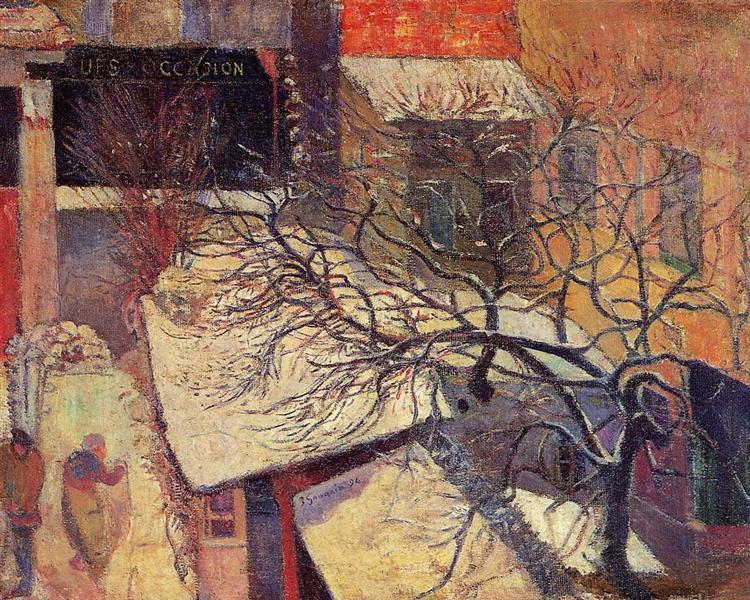Description
Paul Gauguin's Paris in the Snow (1894) is a fascinating example that encapsulates the duality of symbolism and post-impressionism, two currents that characterize the artist's career. Painted during a period when Gauguin was torn between European tradition and his desire to experiment with more exotic themes, this work stands out for its depiction of urban life in a wintry context that is at once melancholic and vibrant.
The composition of “Paris in the Snow” is articulated around an urban landscape that evokes a feeling of loneliness and isolation. The streets, covered by a white blanket of snow, are populated by human figures that, despite being part of the environment, seem to almost blur into it. This stylistic choice reinforces a sense of disconnection, which can be interpreted as a reflection of Gauguin’s own experience in the Parisian metropolis. Snow, often associated with purity or coldness, here becomes an element that lends an aura of melancholy and nostalgia.
The use of colour in the painting is particularly notable. Gauguin adopts a palette that, although it falls within the realm of Impressionism, introduces more intense tones that suggest a more emotional approach. Cool greys and blues predominate, but touches of warmer colours emerge that seem to awaken the scene. On the horizon, buildings can be glimpsed that, although recognisable, are not presented with the same sense of detail that characterised Impressionist painting, which reinforces the idea of a representation that is more subjective than objective.
The characters in Paris in the Snow are few and far between, often featuring heads and hats that seem to lose their individual identity. This anonymous representation of the human figure suggests a critique of the depersonalization of the self in modern life, a theme that would resonate in the work of Gauguin and many of his contemporaries. These figures, often directed and motionless, are stripped of action and, possibly, purpose. As in many of his works, Gauguin seems to be exploring the relationship between the individual and the environment, in this case a desolate and cold Paris, which contrasts with the warmth that might be evoked when speaking of Parisian life.
The atmosphere of the work is further characterised by a loose and textured brushstroke technique, which reveals the influence of symbolism and the search for an emotional representation over a mere reproduction of reality. The buildings, which rise towards the sky, seem to blend with the air, as if the space were distorted according to the painter's emotional state. This interaction between form and colour suggests the symptomatology of winter, where the cold is not only meteorological, but also a reflection of the social atmosphere.
Throughout his career, Gauguin would explore these themes in greater depth, seeking refuge in exotic locales such as Tahiti, but Paris in the Snow stands as an intense and thoughtful examination of human existence in a large city. The work can also be read as a bridge between his earlier achievements as an impressionist painter and his later legacy as a precursor of modernism and symbolic art. In this way, Gauguin's unmistakable imprint on Paris in the Snow invites us to contemplate not only a landscape, but also a mood and a social critique that resonates throughout his work and art history.
KUADROS ©, a famous painting on your wall.
Hand-made oil painting reproductions, with the quality of professional artists and the distinctive seal of KUADROS ©.
Painting reproduction service with satisfaction guarantee. If you are not completely satisfied with the replica of your painting, we will refund 100% of your money.

